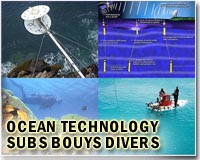| . |  |
. |
Paris (AFP) Nov 17, 2010 Banning nets in the Mediterranean that can capture thousands of bluefin tuna at once is a "realistic scenario," the head of the multinational body managing tuna fishing in the Atlantic said Tuesday. "One of the things that is being discussed is the possible suspension of purse seine fishing and the caging activities," said Fabio Hazin, chairman of the International Commission for the Conservation of Atlantic Tunas (ICCAT). Hazin's comments came on the eve of a key 10-day meeting in Paris of the 48-member ICCAT, which sets the rules and quotas for Atlantic fisheries. He was commenting on a joint call earlier in the day by four major non-governmental groups to suspend the use of the massive draw-string nets, which also serve as floating pens to transport tuna to off-coast farms where they are fattened for market. "This is a realistic scenario," he said at a discussion forum. Japan consumes 80 percent of the Atlantic bluefin catch mainly in the form of raw-fish sushi and sashimi. Driven by wholesale prices that can rise to more than 100,000 dollars per specimen, industrial-scale fishing in the Mediterranean and eastern Atlantic has depleted stocks by 85 percent over the last 40 years, scientists say. ICCAT member states have disagreed sharply going into the meeting as to whether next year's quotas should remain at 13,500, as in 2010, or be cut in half or even suspended. France's fisheries minister, Bruno Le Maire, said his country favoured maintaining the 13,500 level, a position backed by fishing nations Spain and Italy. Britain and Germany, along with EU Fisheries Commissioner Maria Damanaki, have come out in favour of a sharp reduction. The European Union was supposed to forge a common position going into the meeting, but has so far failed to do so. Conservation groups argue that only a complete suspension is sure to allow the species to recover. ICCAT's scientific committee said last month that extending the 2010 catch limit for each of the next three years would give bluefin in the eastern Atlantic and Mediterranean a 63-percent chance of attaining so-called "maximum sustainable yield" by 2022. "The commissioners should be precautionary and not go for the higher range of possibility," Hazin said. "But that is only my personal view." Before the introduction of purse-seine fishing and tuna ranching in the 1990s, bluefin were caught using more artisnal and traditional methods.
Share This Article With Planet Earth
Related Links Water News - Science, Technology and Politics
 Shark sanctuary declared in eastern Indonesia
Shark sanctuary declared in eastern IndonesiaJakarta (AFP) Nov 16, 2010 Indonesia has declared a vast sanctuary for sharks, turtles and manta rays in a region known as one of the world's richest sources of marine biodiversity, officials and conservationists said Tuesday. The sanctuary covers 46,000 square kilometers (17,760 square miles) of waters around the Raja Ampat islands in eastern Indonesia, part of the so-called Coral Triangle region of Southeast Asia. ... read more |
|
| The content herein, unless otherwise known to be public domain, are Copyright 1995-2010 - SpaceDaily. AFP and UPI Wire Stories are copyright Agence France-Presse and United Press International. ESA Portal Reports are copyright European Space Agency. All NASA sourced material is public domain. Additional copyrights may apply in whole or part to other bona fide parties. Advertising does not imply endorsement,agreement or approval of any opinions, statements or information provided by SpaceDaily on any Web page published or hosted by SpaceDaily. Privacy Statement |